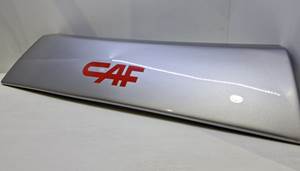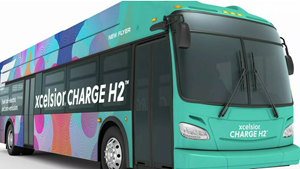Lightweight, battery-powered rail design under development in U.K.
The Warwick Manufacturing Group at the University of Warwick is working alongside Transport Design International to develop a battery-powered, lightweight, rail-based vehicle to operate in Coventry, U.K.
Engineers and researchers at the Warwick Manufacturing Group at the University of Warwick (WMG, Coventry, U.K.) are working alongside Transport Design International (TDI, Stratford, U.K.) to develop a battery-powered, lightweight, rail-based vehicle to operate in Coventry, U.K.
The WMG team, including engineers Darren Hughes and Andrew McGordon, are using their automotive engineering and battery expertise to assist TDI with the design of the vehicle for Coventry City Council, and they currently have a 3D simulation of the vehicle.
The vehicle will be battery-powered with the long-term objective that it will become an autonomous vehicle. It will hold 50 passengers, and the longer-term aim is that it will work like the London Underground system, where there is no timetable and people can hop on and off. Due to being battery-powered, there will be no overhead power supply which is both costly and has a negative impact to the city-scape. This feature provides future flexibility for operating on other non-electrified routes.
The vehicle will be a lightweight design using multiple materials including aluminum, steel and composites. The design is available to view in 3D via WMG’s visualization suite and the first test vehicle will be manufactured by mid-2020. TDI have partnered with Coventry-based Company RDM who will manufacture the vehicle once the design is complete. A team of experts are also working to develop a new track system.
The Government’s Local Growth Fund through the Coventry and Warwickshire Local Enterprise Partnership (CWLEP) has contributed £2.46 million towards phase one of the research and design of the prototype and £12.2 million has been secured from the West Midlands Combined Authority (WMCA) Devolution Deal to undertake the research and development required to prove the VLR concept.
The WMCA has also allocated specialist resource from Transport for West Midlands to provide technical support, advice and guidance to the project team.
“The Coventry light-rail system will be innovative in bringing together technologies from a number of sectors to deliver a low-cost environmentally-sustainable public transport solution for the City of Coventry,” says Dr. Darren Hughes, associate professor at WMG, University of Warwick. “Seeing the 3D simulation and envisaging how it will look within Coventry makes us look forward to building the first vehicle that will be ready for testing at a test track facility during 2020.”
“Very Light rail is a fantastic innovation and it has the potential to transform the way people travel,” says Councillor Jim O’Boyle, cabinet member for jobs and regeneration. “It will be much more affordable to install than traditional trams, take up far less road space, be able to run alongside traffic and our ultimate aim is that it doesn’t require a driver so it can be a frequent service. Coventry has a rich traditional of vehicle manufacturing and now we are leading the way in future transport too. This Very Light Rail work, combined with our work on driverless and connected cars puts us right at the forefront of creating new, ground breaking solutions for future transport needs. They will be safer and more environmentally friendly and I hope go on to provide good job opportunities for local people too.”
“Coventry and Warwickshire is at the forefront of battery technology and this exciting scheme emphasizes our skills at leading the way in innovation,” says Jonathan Browning, chair of the CWLEP. “This new technology will bring more jobs and investment to Coventry and Warwickshire and it underlines the value of partnership working to boost the area’s economy. It is great news that the prototype of the Very Light Rail vehicle will be built ahead of Coventry being UK City of Culture in 2021 when the area’s profile will be boosted on a global stage.”
Related Content
SABIC debuts EN45545 rail-compliant, fiber-reinforced compound
LNP Thermocomp AM DC0041XA51 offers the rail industry a solution that can be used for on-demand printing of large, complex exterior and interior parts in relatively small build numbers.
Read MoreHexagon Purus opens new U.S. facility to manufacture composite hydrogen tanks
CW attends the opening of Westminster, Maryland, site and shares the company’s history, vision and leading role in H2 storage systems.
Read MoreNew Flyer selects Hexagon Purus H2 tanks for fifth consecutive year
Type 4 tanks will continue to be supplied for the mass mobility provider’s Xcelsior Charge FC fuel cell electric transit buses.
Read MoreLongtime partner New Flyer selects Hexagon Purus to outfit hydrogen transit bus
Hexagon Purus will continue to supply Type IV hydrogen tanks for the Xcelsior Charge H2 fuel cell electric bus, the tanks of which will be produced out of Hexagon’s new Maryland facility.
Read MoreRead Next
Developing bonded composite repair for ships, offshore units
Bureau Veritas and industry partners issue guidelines and pave the way for certification via StrengthBond Offshore project.
Read More“Structured air” TPS safeguards composite structures
Powered by an 85% air/15% pure polyimide aerogel, Blueshift’s novel material system protects structures during transient thermal events from -200°C to beyond 2400°C for rockets, battery boxes and more.
Read MoreAll-recycled, needle-punched nonwoven CFRP slashes carbon footprint of Formula 2 seat
Dallara and Tenowo collaborate to produce a race-ready Formula 2 seat using recycled carbon fiber, reducing CO2 emissions by 97.5% compared to virgin materials.
Read More
.jpg;width=70;height=70;mode=crop)

























